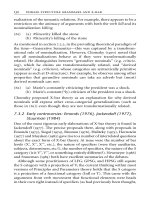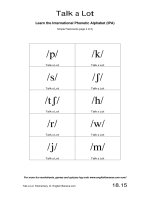MARKETING RESEARCH PART 16 pptx
Bạn đang xem bản rút gọn của tài liệu. Xem và tải ngay bản đầy đủ của tài liệu tại đây (523.25 KB, 48 trang )
Generalizing a
Sample’s Findings to
Its Population and
Testing Hypotheses
About Percents and
Means
Statistics Versus Parameters
• Statistics: values that are computed
from information provided by a sample
• Parameters: values that are computed
from a complete census which are
considered to be precise and valid
measures of the population
• Parameters represent “what we wish
to know” about a population. Statistics
are used to estimate population
Ch 16
2
parameters.
Ch 16
3
The Concepts of Inference and
Statistical Inference
• Inference: drawing a conclusion
based on some evidence
• Statistical inference: a set of
procedures in which the sample size
and sample statistics are used to
make estimates of population
parameters
Ch 16
4
Ch 16
5
How to Calculate Sample Error
(Accuracy)
error = z
pq
n
Where z = 1.96 (95%)
or 2.58 (99%)
2000
1850
1700
1550
1400
1250
1100
950
8 00
6 50
500
350
2 00
16%
14%
12%
10%
8%
6%
4%
2%
0%
50
sp
Accuracy
Sample Size and Accuracy
Sample Size
Ch 16
6
Accuracy Levels for Different
Sample Sizes
The “p” you found in your sample
• At 95% ( z = 1.96)
• n
p=50%
•
•
•
•
•
10
100
250
500
1,000
Ch 16
±31.0%
±9.8%
±6.2%
±4.4%
±3.1%
p=70%
±28.4%
±9.0%
±5.7%
±4.0%
±2.8%
p=90%
±18.6%
±5.9%
1.96 times sp
±3.7%
±2.6%
±1.9%
95% Confidence interval: p ± 1.96 times sp
7
Parameter Estimation
• Parameter estimation: the process of
using sample information to compute
an interval that describes the range of
values of a parameter such as the
population mean or population
percentage is likely to take on
Ch 16
8
Parameter Estimation
•
Ch 16
Parameter estimation involves three
values:
1. Sample statistic (mean or percentage
generated from sample data)
2. Standard error (variance divided by
sample size; formula for standard error
of the mean and another formula for
standard error of the percentage)
3. Confidence interval (gives us a range
within which a sample statistic will fall
if we were to repeat the study many
9
times over
Parameter Estimation
• Statistics are generated from sample data
and are used to estimate population
parameters.
• The sample statistic may be either a
percentage, i.e., 12% of the respondents
stated they were “very likely” to patronize a
new, upscale restaurant OR
• The sample statistic may be a mean, i.e.,
the average amount spent per month in
restaurants is $185.00
Ch 16
10
Parameter Estimation
• Standard error: while there are two
formulas, one for a percentage and
the other for a mean, both formulas
have a measure of variability divided
by sample size. Given the sample
size, the more variability, the greater
the standard error.
Ch 16
11
Parameter Estimation
• The lower the standard error, the
more precisely our sample statistic
will represent the population
parameter. Researchers have an
opportunity for predetermining
standard error when they calculate
the sample size required to
accurately estimate a parameter.
Recall Chapter 13 on sample size.
Ch 16
12
Standard Error of the Mean
Ch 16
13
Standard Error of the
Percentage
Ch 16
14
Parameter Estimation
• Confidence intervals: the degree of
accuracy desired by the researcher
and stipulated as a level of
confidence in the form of a
percentage
• Most commonly used level of
confidence: 95%; corresponding to
1.96 standard errors
Ch 16
15
Parameter Estimation
• What does this mean? It means that
we can say that if we did our study
over 100 times, we can determine a
range within which the sample
statistic will fall 95 times out of 100
(95% level of confidence). This gives
us confidence that the real population
value falls within this range.
Ch 16
16
How do I interpret the confidence
interval?
• Theoretical notion
• Take many, many, many samples
2.5%
2.5%
• Plot the p’s
• 95 % will fall in confidence interval
95%
(p ± z times sp)
Ch 16
17
Parameter Estimation
• Five steps involved in computing
confidence intervals for a mean or
percentage:
1. Determine the sample statistic
2. Determine the variability in the
sample for that statistic
Ch 16
18
Parameter Estimation
3. Identify the sample size
4. Decide on the level of confidence
5. Perform the computations to
determine the upper and lower
boundaries of the confidence
interval range
Ch 16
19
Parameter Estimation Using
SPSS: Estimating a Percentage
• Run FREQUENCIES (on
RADPROG) and you find that 41.3%
listen to “Rock” music.
• So, set p=41.3 and then q=58.7,
n=400, 95%=1.96, calculate Sp.
• The answer is 36.5%-46.1%
• We are 95% confident that the true %
of the population that listens to
“Rock” falls between 36.5% and
46.1%. (See p. 464).
Ch 16
20
sp = z
How to Compute a Confidence
pq Interval for a Percent
n
•
Determine the confidence
interval using
• Sample size (n)
• 95% level of confidence
(z=1.96)
• P=?%; q=100%-?%
p − z
Ch 16
pq
n
Lower boundary
p + z
pq
n
Upper boundary
21
Estimating a Population
Percentage with SPSS
• How do we interpret the
results?
– Our best estimate of the
population percentage
that prefers “Rock” radio
is 41.3 percent, and we
are 95 percent confident
that the true population
value is between 36.5
and 46.1 percent.
Ch 16
22
Parameter Estimation Using
SPSS: Estimating a Mean
• SPSS will calculate a confidence
interval around a mean sample
statistic.
• From the Hobbit’s Choice data
assume
– We want to know how much those
who stated “very likely” to patronize
an upscale restaurant spend in
restaurants per month. (See p.
465.)
Ch 16
23
Parameter Estimation Using
SPSS: Estimating a Mean
• We must first use DATA, SELECT
CASES to select LIKELY=5.
• Then we run ANALYZE, COMPARE
MEANS, ONE SAMPLE T-TEST.
• Note: You should only run this test
when you have interval or ratio data.
Ch 16
24
Ch 16
25









